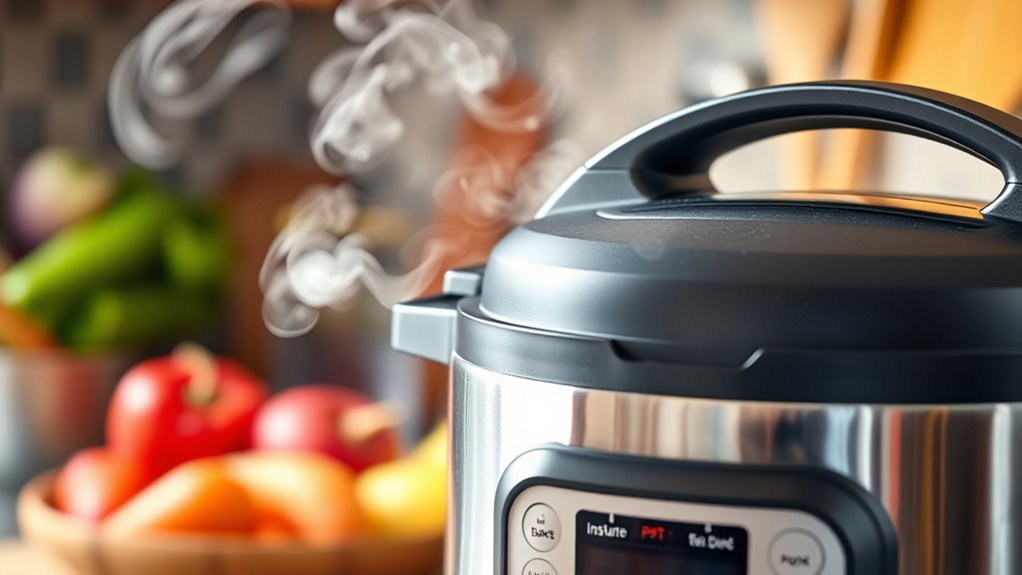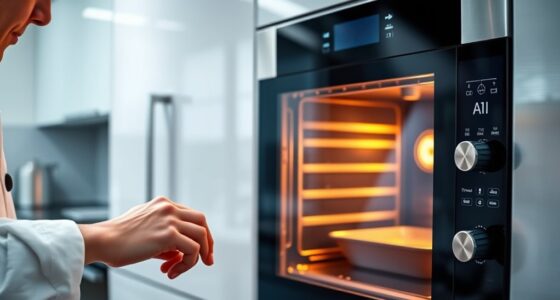Instant Pots cook food faster by increasing internal pressure, which raises the boiling point of water above 212°F. This sealed environment traps steam, elevating temperature and speeding up heat transfer. The higher pressure also accelerates chemical reactions in food, breaking down tough fibers and proteins quickly. Modern safety features ensure reliable operation without risks. If you want to understand the science behind this rapid cooking process, keep exploring how pressure and design work together.
Key Takeaways
- Instant Pots use airtight sealing to trap steam, increasing internal pressure and temperature for faster cooking.
- Elevated pressure raises the boiling point of water above 212°F, enabling higher cooking temperatures.
- Higher internal temperature accelerates chemical reactions, breaking down food molecules more quickly.
- Safety features like pressure gauges and valves maintain optimal pressure, ensuring efficiency and safety.
- Increased pressure shortens cooking times for ingredients like beans and meats by speeding heat transfer.
The Basics of Pressure Cooking
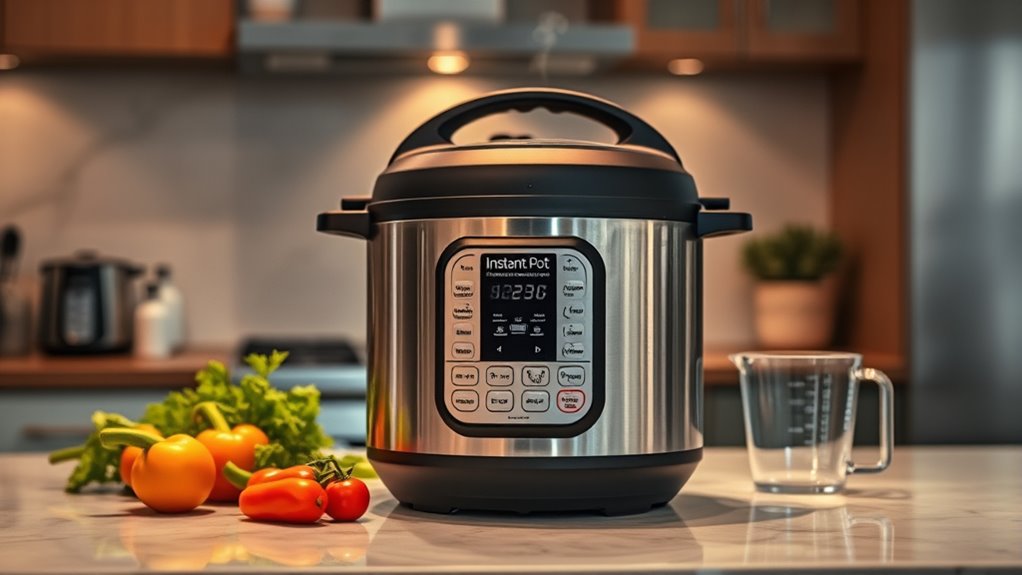
Pressure cooking works by trapping steam inside a sealed container, which raises the boiling point of water and cooks food faster. As the pressure increases, you’ll see the pressure gauge rise, indicating the internal pressure level. This gauge helps you monitor cooking and guarantees safety. Most pressure cookers have a safety lock that prevents the lid from opening while under pressure, protecting you from potential burns or accidents. When you set the cooker to cook, the safety lock engages, securing the lid in place. Once the pressure reaches the desired level, the cooker maintains it, cooking your food efficiently. Understanding how the pressure gauge and safety lock work together is essential for safe and effective pressure cooking. They’re key features that keep you safe while speeding up your cooking process. Recognizing the importance of proper safety features can help prevent accidents and ensure optimal results.
How Increased Pressure Raises Boiling Points
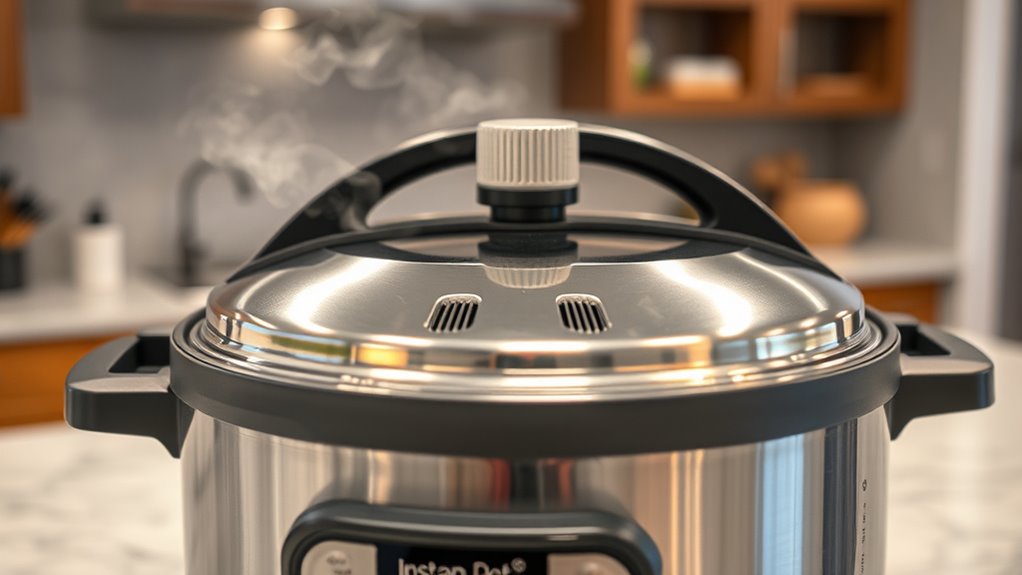
When you increase the pressure inside a pressure cooker, you raise the boiling point of water beyond its normal 212°F (100°C). This occurs because the pressure gauge shows higher pressure, which pushes water molecules closer together, requiring more heat to boil. The sealing ring ensures the cooker remains airtight, allowing pressure to build safely. As pressure rises, so does the boiling point, speeding up cooking times. Here’s how different pressures affect boiling points: pressure levels significantly influence cooking efficiency and food texture.
The Role of Steam and Sealing in a Pressure Cooker
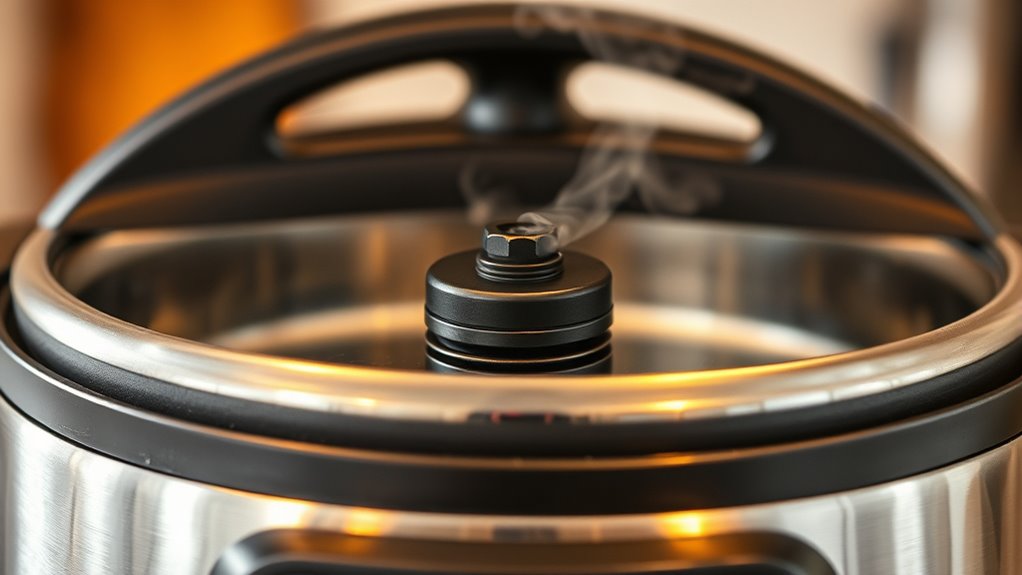
When you seal the lid tightly, it traps steam inside, building up pressure. This steam raises the cooking temperature and keeps food from escaping. Without proper sealing, the pressure and efficiency of your cooker drop markedly. Additionally, the use of immersive soundscapes in advertisements highlights the importance of sensory elements, much like how a well-sealed lid creates an optimal cooking environment.
Sealing Locks in Pressure
A pressure cooker relies on effective sealing locks to keep steam contained, which is essential for building up the high pressure needed for faster cooking. The pressure lock, often a sturdy lid latch, ensures the lid stays securely in place during operation. When you close the lid properly, it engages the safety valve, which releases excess pressure if it gets too high, preventing accidents. This seal traps steam inside, raising the internal temperature rapidly. A tight seal not only maintains consistent pressure but also prevents steam from escaping prematurely, ensuring your food cooks efficiently. Always confirm the pressure lock clicks into place and the safety valve is functioning before starting. Proper sealing is critical for both safety and ideal cooking performance. Regularly checking the seal integrity of your pressure cooker helps ensure it functions safely and effectively.
Steam Elevates Cooking Temperature
Because the seal traps steam inside, it allows the pressure cooker to reach higher temperatures than boiling water alone. This elevated temperature speeds up cooking by breaking down food faster. The sealing mechanisms ensure the steam stays inside until enough pressure builds up, raising the temperature. When pressure reaches a certain point, you can perform a pressure release to safely vent excess steam. This controlled environment maximizes heat transfer and reduces cooking time substantially. Additionally, Automation’s role in business intelligence enables precise control and monitoring of pressure levels for optimal cooking performance.
Prevents Food From Escaping
The sealing mechanism in a pressure cooker plays a vital role in preventing food and steam from escaping during cooking. When you lock the lid, it creates an airtight seal that keeps steam inside, maintaining the high pressure needed for faster cooking. This prevents steam escape, which would otherwise lower the pressure and slow down the process. The seal also ensures that food stays contained, avoiding messes and uneven cooking. When cooking is complete, you use the pressure release to safely vent steam, preventing sudden pressure drops that could cause food to escape or splatter. Proper sealing and controlled pressure release are essential for safety and efficiency, helping your food cook quickly and evenly while minimizing steam escape throughout the process. Additionally, the sealing mechanism is designed to withstand high pressure while ensuring safety during operation.
Temperature Dynamics Inside an Instant Pot
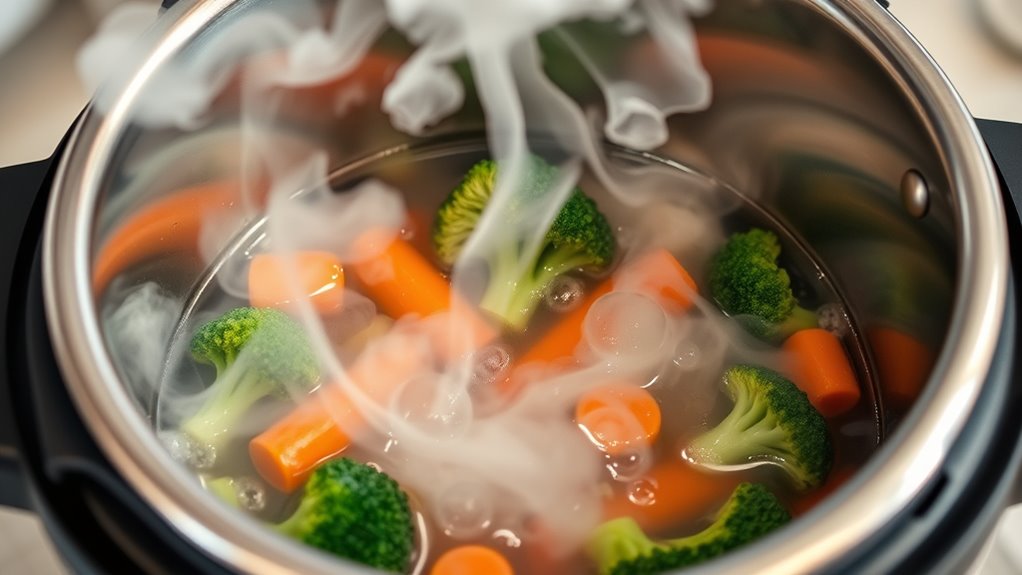
Inside an Instant Pot, temperature dynamics are essential for proper cooking, as the device relies on precise heat control to achieve consistent results. You’ll notice that pressure fluctuations directly influence temperature, affecting how heat transfers within the pot. When pressure rises, temperatures increase, speeding up cooking. Conversely, as pressure drops, temperatures decrease, slowing the process. Understanding these interactions helps you manage cooking times effectively. Here are key points:
Inside an Instant Pot, pressure fluctuations directly impact temperature, influencing cooking speed and consistency.
- Increased pressure boosts temperature, accelerating heat transfer.
- Fluctuations in pressure cause corresponding temperature changes.
- Consistent heat transfer ensures even cooking.
- Proper sealing maintains stable pressure and temperature levels.
- The tuning of pressure and temperature is crucial for optimal cooking performance.
Mastering these dynamics guarantees your dishes cook faster and more evenly every time.
The Chemistry of Food Breakdown Under Pressure
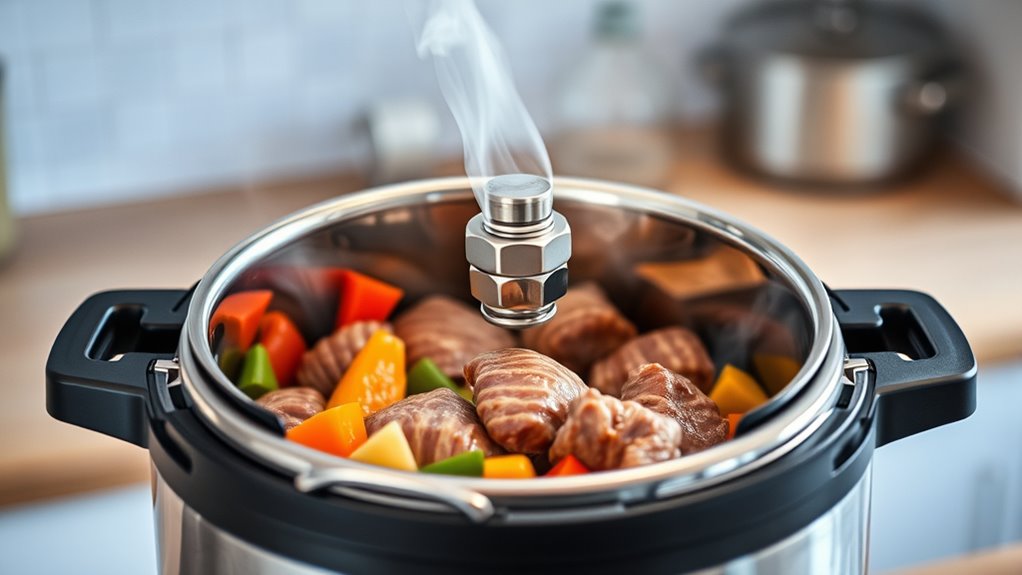
When you cook food under pressure, the high temperature and moisture levels accelerate chemical reactions that break down complex molecules. This process involves pressure-induced denaturation, where proteins unfold and become more accessible to enzymes and other molecules. As proteins denature, they release amino acids and peptides, enhancing flavor development. Simultaneously, the heat causes cell walls to weaken, releasing flavor compounds trapped inside. The pressure also speeds up the breakdown of carbohydrates into simpler sugars, which contribute to taste and aroma. This combination of chemical changes results in tender textures and intensified flavors. The pressure effectively transforms tough cuts of meat or fibrous vegetables into soft, flavorful dishes in less time, thanks to these accelerated chemical reactions that occur under pressure. Additionally, understanding the chemical transformations during pressure cooking can help optimize recipes for better flavor and texture.
How Pressure Accelerates Chemical Reactions
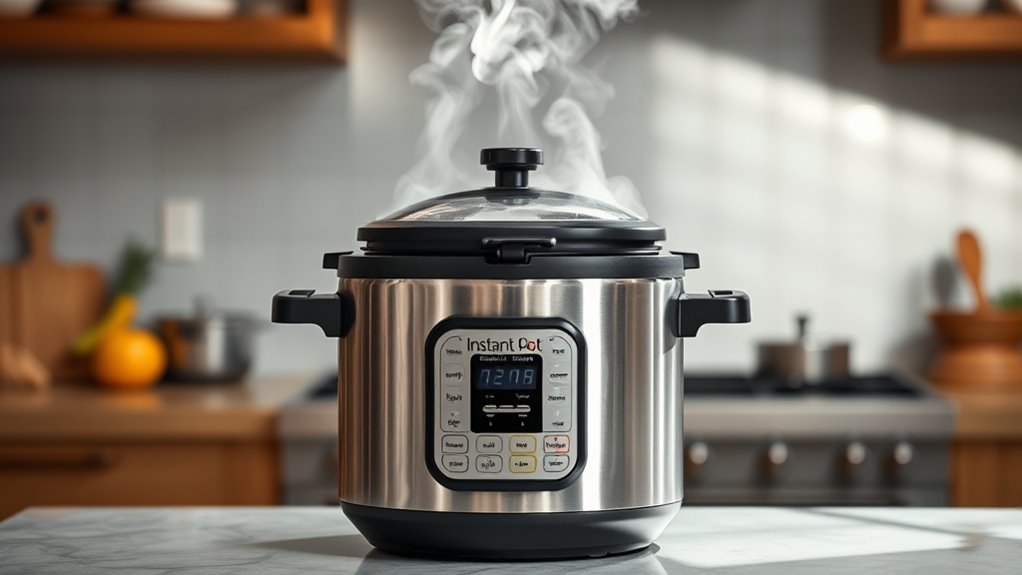
When you increase the pressure in a cooker, chemical reactions happen faster because molecules collide more often and with greater energy. This elevated pressure also raises the boiling point, allowing food to cook at higher temperatures without boiling away water. As a result, your meals cook in less time, making the process more efficient and effective. Additionally, advanced heat transfer technologies in modern pressure cookers help optimize cooking speed and energy use.
Increased Reaction Rates
Have you ever wondered how pressure speeds up chemical reactions in a pressure cooker? It all comes down to pressure induced changes that lead to reaction rate enhancement. When pressure increases, molecules are forced closer together, increasing collision frequency and energy. This boosts the likelihood of reactions occurring faster. Here are four key points:
- Higher pressure reduces the activation energy needed for reactions.
- Molecules collide more often and with greater force.
- Reaction pathways become more accessible under pressure.
- Increased pressure accelerates the breakdown of complex molecules.
- Chemical kinetics explains how pressure influences reaction speed by affecting molecular interactions.
These effects work together to speed up cooking, making food tender faster. By understanding pressure induced changes, you see how pressure cooker science harnesses reaction rate enhancement to save time and improve efficiency.
Elevated Boiling Point
Elevated pressure increases the boiling point of liquids, which in turn accelerates chemical reactions. This process, known as pressure induced boiling, occurs because higher pressure raises the vapor pressure needed for a liquid to boil. When you cook in an instant pot, the trapped steam creates pressure that pushes the boiling point above 212°F (100°C). As a result, foods cook faster since heat is transferred more efficiently at higher temperatures. The increased vapor pressure suppresses the formation of bubbles, allowing liquids to reach higher temperatures without boiling away. This elevated boiling point is key to quickening cooking times, as reactions happen faster at higher temperatures, making pressure cookers an effective tool for reducing overall cooking duration.
Shorter Cooking Times
By increasing the boiling point through higher pressure, a pressure cooker allows heat to be applied more efficiently, which speeds up chemical reactions within the food. This results in markedly shorter cooking times, saving you time in the kitchen. To maximize cooking efficiency and ensure kitchen safety, keep these points in mind:
- Higher pressure lowers cooking time for tougher ingredients like beans and meats.
- Faster heat transfer accelerates flavor development.
- Reduced cooking duration minimizes nutrient loss.
- Proper sealing prevents accidents and maintains consistent pressure.
Understanding how pressure accelerates chemical reactions helps you cook smarter and safer. Always follow safety guidelines, and you’ll enjoy quick, nutritious meals without sacrificing quality or safety.
Comparing Traditional and Pressure Cooking Times
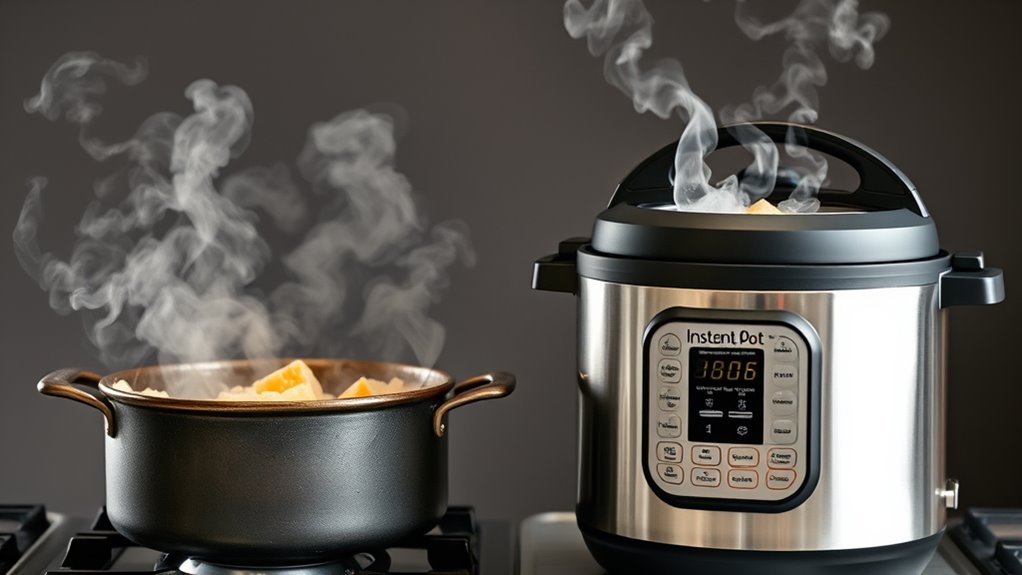
When comparing traditional and pressure cooking times, it’s clear that pressure cooking offers significant time savings. Many pressure cooker myths suggest they’re complicated or less flavorful, but they actually speed up cooking without sacrificing quality. Traditional cooking techniques, like simmering or slow roasting, often take hours, especially for tougher cuts of meat or dried beans. In contrast, a pressure cooker can tenderize these ingredients in a fraction of the time—sometimes under 30 minutes. This efficiency isn’t just about saving time; it also reduces energy use. While conventional methods rely on long, slow heat, pressure cookers use high pressure to raise boiling points, cooking food faster and more evenly. So, if you want quick, flavorful results, pressure cooking clearly outpaces traditional techniques.
The Impact of Pressure Cooking on Nutrients and Flavors
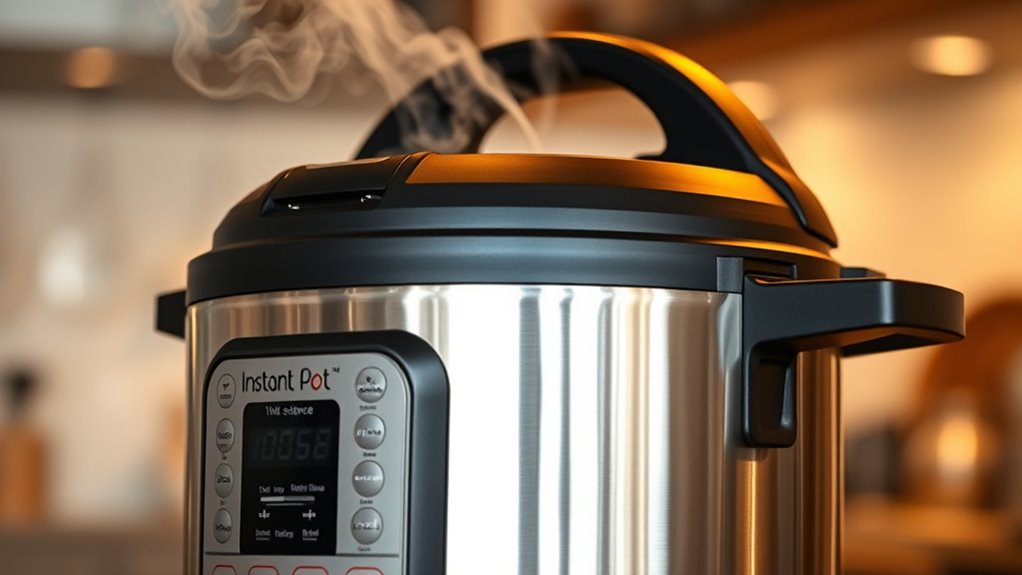
Pressure cooking can preserve more nutrients and flavors than you might expect, thanks to its quick cooking times and sealed environment. This method helps retain nutrient retention by minimizing nutrient loss through reduced exposure to heat and oxygen. It also enhances flavor because the sealed environment traps aromas and juices, intensifying taste.
Here are four key impacts:
- Maximized nutrient retention due to shorter cooking durations.
- Preserved vitamins and minerals that degrade with prolonged heat.
- Flavor enhancement from concentrated steam and sealed environment.
- Reduced nutrient leaching into cooking water, keeping ingredients nutritious.
Safety Mechanisms and Design Features of Modern Pressure Cookers
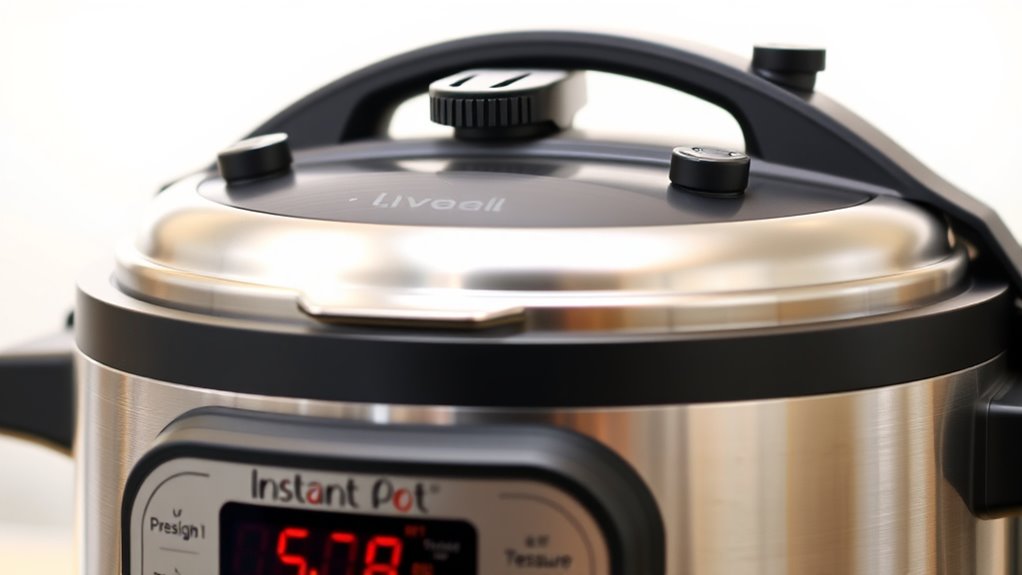
Modern pressure cookers are equipped with advanced safety mechanisms that guarantee reliable operation and protect users from potential hazards. These features ensure pressure cooker safety by preventing accidents and malfunctions. One key component is the modern sealing mechanism, which creates a secure, airtight environment to maintain consistent pressure. When pressure builds up to safe levels, the lid locks securely, preventing accidental opening. If pressure exceeds safe limits, safety valves automatically release excess steam, avoiding dangerous over-pressurization. Many models also include pressure indicators, allowing you to monitor cooking progress easily. Additionally, some pressure cookers have multiple safety features like thermal sensors and locking mechanisms that activate if irregularities occur. These design features make modern pressure cookers safe, efficient, and user-friendly, giving you peace of mind during cooking.
Frequently Asked Questions
How Does the Size of an Instant Pot Affect Cooking Times?
The size of your Instant Pot influences cooking times because larger models require more energy to heat and pressurize. Size variations affect cooking efficiency, with smaller pots heating up faster and cooking quicker for smaller quantities. Conversely, bigger pots take longer to reach pressure but can cook larger meals at once. So, your choice of size impacts how quickly your food cooks and how efficiently you use your appliance.
Can Pressure Cookers Be Used for Baking or Desserts?
You can definitely use a pressure cooker for baking and dessert preparation. Pressure cooker baking works well for recipes like cheesecakes, puddings, and even cakes, thanks to its moist environment. It’s great for creating tender, flavorful desserts without an oven. Just make certain you use the right heat and container, and follow specific recipes designed for pressure cooker baking to get the best results.
What Materials Are Safest for Pressure Cooker Construction?
When choosing a pressure cooker, you want to focus on material safety and construction durability. Look for options made from stainless steel, which resists corrosion and doesn’t leach harmful substances. Avoid cheap or non-stainless materials that may degrade or release toxins over time. A well-constructed pressure cooker with durable materials guarantees safe cooking, longevity, and peace of mind, especially when preparing meals for your family.
How Do Altitude Changes Influence Pressure Cooking Efficiency?
Did you know that at higher altitudes, water boils below 212°F? This means altitude adjustment is crucial for pressure cooking—your cooking time increases because the lower boiling point makes food take longer to cook. When you cook at elevated altitudes, you need to modify your pressure cooker’s settings or increase cooking time to guarantee your food is thoroughly cooked and safe to eat.
Are There Limits to the Types of Foods Suitable for Pressure Cooking?
You might wonder if all foods work well in a pressure cooker. While many ingredients benefit from faster cooking, some face ingredient limitations, especially if they can turn mushy or lose their desired food texture. For example, delicate vegetables or soft fruits may not hold up well. So, consider the food’s texture and how it reacts to pressure cooking to guarantee the best results without compromising quality.
Conclusion
Think of your Instant Pot as a gateway to faster transformation, where pressure acts as a silent conductor, guiding ingredients through a symphony of heat and steam. It symbolizes your mastery over time and tradition, turning patience into precision. As you embrace this modern alchemy, remember that beneath the simple lid lies a vessel of potential—where science and culinary art unite to reveal flavors and textures once thought impossible.
